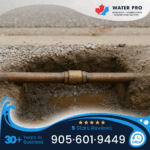Basement waterproofing is a common need for homeowners across Toronto, the GTA, and the Golden Horseshoe. Many homeowners first notice moisture at the floor–wall joint, damp corners, or a musty odour after heavy rain or spring thaws. These signs often relate to surface runoff, clay soils, or hydrostatic pressure acting on older foundations.
It’s helpful to know that Water Pro Master Corp offers fast 24/7 assistance, free estimates, licensed and insured service, and warranty-backed work. If you’d like a quick discussion or to schedule a free estimate, call (905) 601-9449 and we’ll book a time that fits your schedule.
Understanding Basement Waterproofing Needs In Toronto
It’s helpful to know the local causes and common signs of basement moisture in the Toronto area.
Definitions in plain terms help homeowners plan. A weeping tile (perimeter drain) redirects groundwater; a sump pump lifts collected water out and away; a backwater valve prevents sewer backflow; hydrostatic pressure is the force groundwater can put on a foundation wall.
- What it feels like: damp corners, salt deposits on block walls, wet carpet edge, or a musty odour when humidity is high.
- Where it is common: older neighbourhoods with clay soils or combined sewers, low lot grading, and heavy spring runoff.
- Typical fixes we discuss: grading and downspout changes, interior perimeter drains and sump systems, backwater valve installation, and pipe relining when laterals are damaged. For detailed system options, see our basement waterproofing page.
What A Typical Assessment Looks Like
A licensed technician arrives, documents conditions, and explains the steps they will take during the visit.
On-Site Inspection Steps
During the inspection we look at visible and surrounding conditions to form a practical plan for your home.
- Visual checks of the floor–wall joint, wall finishes, and the sump pit if present.
- Exterior grading, gutters, and downspout discharge distance from the foundation.
- Notes and photographs to document locations, times of prior incidents, and any previous repairs or invoices you provide.
Diagnostic Tests And Why They Matter
Where indicated, we use targeted diagnostics to find hidden issues before recommending work.
- CCTV inspection of lateral drains and sewer connections when sewer backflow or a damaged pipe is suspected.
- Simple flow tests at floor drains and temporary water pours to observe how water moves away from the home.
- Moisture mapping and a review of permits or municipal subsidy options, so the recommended approach fits local code and funding timelines.
Common Fixes, Timelines, And Typical Costs
A few considerations we review together when choosing a fix and planning a budget for Toronto-area homes.
Common solutions address water at the foundation, sewer backflow, or damaged laterals. We present neutral options and typical timeframes so you can compare trade-offs and cost ranges.
- Sump pump installation: Often completed in 1–2 days for a standard interior pit. Typical installed cost ranges from $1,200 to $3,500 depending on pump type, battery backup, and pit work.
- Backwater valve installation: Usually a 1-day interior install when access is clear. Permit requirements vary by municipality; budget $800 to $2,000 as a general range and consult local subsidy rules if applicable.
- Interior perimeter drain with sump: Common in finished basements; expect 3–7 days of work and higher labour for floor restoration. Costs commonly run from $4,000 to $12,000 depending on access and finish repairs.
- Exterior excavation and membrane: When an exterior approach is chosen, work can take 5–10 days and costs more because of excavation and landscaping restoration.
- Pipe and drain relining: If CCTV shows a damaged lateral, trenchless relining is often less disruptive and can be completed in 1 day for a typical lateral. It is a practical alternative to open dig repairs for many properties.
- Underpinning or major structural work: Timelines and budgets vary widely. Planning, engineering reviews, and permits commonly add several weeks to the schedule and substantially affect cost.
Before any work, we review grading, foundation details, and plumbing so the plan fits your home and local code. Every property has nuances; we talk them through so you feel informed and comfortable.
Where sewer connection or lateral damage is suspected, we may recommend pipe & drain relining after a CCTV inspection. For backflow protections and pump systems we discuss options on site and can point to local subsidy programs that sometimes offset costs.
Mini-Case: Sump Pump + Backwater Valve Install
This short numeric example shows how a combined approach can fit a typical Toronto home.
- Scenario: Homeowner has periodic floor drain backup and a wet floor–wall joint after heavy rain.
- Work performed: interior sump pit with primary pump and battery backup, plus a backwater valve on the floor drain.
- Timeline and cost: installation completed in 2 days; invoice $4,200 including a battery backup and labor. Permit applied where required; homeowner applied for municipal subsidy within 12 months.
- Municipal note: subsidy review times vary; some programs state up to 10 weeks for decision. We include permit guidance when we provide your written quote.
Risks, Common Mistakes, And What Homeowners Can Do Next
Every property has nuances; presenting the full picture helps you choose an appropriate path forward without surprises.
Common mistakes include leaving downspouts too close to foundations, using undersized pumps, or relying on temporary patching without diagnosing the root cause. Skipping permits or work by unlicensed installers can create code or insurance complications.
- What may happen if left unaddressed: repeated seepage at the floor–wall joint, higher cleanup or finish repair costs, or repeated sewer backups in connected systems. We state this calmly so you can make an informed choice.
- Routine professional steps to reduce risk: proper grading and downspout discharge, correct pump sizing and battery backup for power outages, and verifying valve and pump installations meet local code.
- Maintenance advice: test the sump by pouring water into the pit, check that exterior discharge points remain clear, and schedule pump service annually with a licensed plumber.
We do not recommend DIY work for sump, sewer, or structural fixes. Licensed technicians and permits protect safety and long-term performance. If you have immediate concerns about sewer backup, call a licensed professional promptly.
Next Steps To Book A Licensed Assessment
Before any work begins, the most useful next step is a licensed on-site assessment that includes a photo record, diagnostic checks, and a written estimate with timelines and financing or subsidy guidance where applicable.
When you contact us we will schedule a convenient time for a technician to visit, review options in plain language, and provide a written quote that notes permit needs and typical timelines. For questions or to arrange a free estimate, please contact us or call (905) 601-9449.
This article offers general information for homeowners and is not engineering, legal, or plumbing advice. Assessments and solutions are reviewed during an on-site visit by licensed professionals. If you’re considering waterproofing or drain work, feel free to contact us or call — we’ll discuss your goals and outline a plan that feels comfortable and right for your home.
🔗 Learn more: https://waterproofingdrain.com/
📞 Call us: 905 601-9449
✉️ Write us: info@waterproofingdrain.com
🕒 Open hours: Mon – Sat, 9:00am – 9:30pm






